Subtotal: 3.790,20€ (incl. VAT)
The Atlantic’s vital currents could collapse. Scientists are racing to understand the dangers.
On a Saturday morning in December of 2020, the RRS Discovery floated in calm waters just east of the Mid-Atlantic Ridge, the massive undersea mountain range that runs from the Arctic nearly to the Antarctic.
The team onboard the research vessel, mostly from the UK’s National Oceanography Centre, used an acoustic signaling system to trigger the release of a cable more than three miles long from its 4,000-pound anchor on the seabed.
The expedition’s chief scientist, Ben Moat, and others walked up to the bridge to spot the first floats as they popped up. The technicians on deck, clad in hard hats and clipped into harnesses, reeled the cable in. They halted the winch every few minutes to disconnect the floats as well as sensors that measure salinity and temperature at various depths, data used to calculate the pressure, current speed, and volume of water flowing past.
The scientists and technicians are part of an international research collaboration, known as RAPID, that’s collecting readings from hundreds of sensors at more than a dozen moorings dotting the Atlantic roughly along 26.5° North, the line of latitude that runs from the western Sahara to southern Florida.
They are searching for clues about one of the most important forces in the planet’s climate system: a network of ocean currents known as the Atlantic Meridional Overturning Circulation (AMOC). Critically, they want to better understand how global warming is changing it, and how much more it could shift in the coming decades—even whether it could collapse.
“Measuring this ocean system is vital to understanding our climate,” Moat says.
The Atlantic circulation is, effectively, one leg of the world’s mightiest river. It runs tens of thousands of miles from the Southern Ocean to Greenland and back, ping-ponging between the southwestern coast of Africa, the southeastern US, and Western Europe.
The system carries warm, shallow, salty water northward, transporting about 1.2 million gigawatts of heat energy across RAPID’s array of moorings at any moment. That’s equivalent to about 160 times the energy capacity of the entire world’s electricity system. The currents, which heat up the surrounding air as they travel northward, are a major factor (though not the only one) in why Western Europe is warmer than eastern Canada even though they lie at roughly the same latitude.
The waters become cooler and denser as they reach the high latitudes, forcing the currents to dive miles below the surface, spread outward, and bend back southward. That sinking of the water deep into the ocean helps propel the system.
The problem is the Atlantic circulation seems to be weakening, transporting less water and heat. Because of climate change, melting ice sheets are pouring fresh water into the ocean at the higher latitudes, and the surface waters are retaining more of their heat. Warmer and fresher waters are less dense and thus not as prone to sink, which may be undermining one of the currents’ core driving forces.
“Measuring this ocean system is vital to understanding our climate.”
Simply put, the currents influence much of the weather we know in the Northern Hemisphere, particularly around the coastal Atlantic but also as far away as Thailand. If the currents change, so too will the weather, disrupting temperature and precipitation patterns that have shaped our lives and societies for centuries.
Some climate models predict that the currents will decline by as much as 45% this century. And evidence from the last ice age shows that the system can eventually switch off or go into a very weak mode, under conditions that global warming may be replicating.
If that happened, it would likely be a climate disaster. It could freeze the far north of Europe, driving down average winter temperatures by more than 10 °C. It might cut crop production and incomes across the continent as much of the land becomes cooler and drier. Sea levels could rise as much as a foot on the Eastern Seaboard, flooding homes and businesses up and down the coast. And the summer monsoons over major parts of Africa and Asia might weaken, raising the odds of droughts and famines that could leave untold numbers without adequate food or water.
It would be a “global catastrophe,” says Stefan Rahmstorf at the Potsdam Institute for Climate Impact Research.
Most scientists say a collapse of the currents is a remote possibility this century, but even a steep slowdown would have significant impacts, potentially cooling and reducing rainfall around the North Atlantic while increasing precipitation across parts of the tropics. It might raise sea level by about five inches off the US southeast coast.
Despite the stakes, scientists have only a coarse comprehension of the currents’ behavior, the balance of the forces that drive them, or their susceptibility to shifting climate conditions. That’s why Moat and others are so keen to observe the Atlantic circulation.
But much of what has been discovered so far is that the Atlantic circulation is more variable, perplexing, and perhaps unpredictable than previously understood.
The Florida Current
NOAA’s Atlantic Oceanographic and Meteorological Laboratory is a squat, white five-story building, fringed by palm trees on Virginia Key, a barrier island just a few miles from downtown Miami.
The warm upper layer of the Atlantic circulation, known here as the Florida Current, races past the island, squeezed between the state and the Bahamas. It’s an ideal place to observe one of the most powerful stretches of the system, because the topography of the Florida Straits confines the currents, which can otherwise span hundreds of miles, down to dozens. (The Florida Current is part of the Gulf Stream, a stretch of the Atlantic circulation that traces the southeastern US before cutting across the ocean to Europe.)
NOAA scientists have been monitoring the Florida Straits at around 27° North almost continuously since 1982, in large part by taking advantage of underwater telephone cables. The now-defunct phone lines along the seafloor provide a cheap, unobtrusive way of observing the Atlantic circulation.
The passing seawater creates a voltage along the sides of the cables, which NOAA researchers found they could reliably measure. They receive daily readings from instruments set up in a telephone trunk room on Grand Bahama Island. With careful calibration, they are able to translate those measurements into estimates of how much water flows across that line of latitude.
How the AMOC works
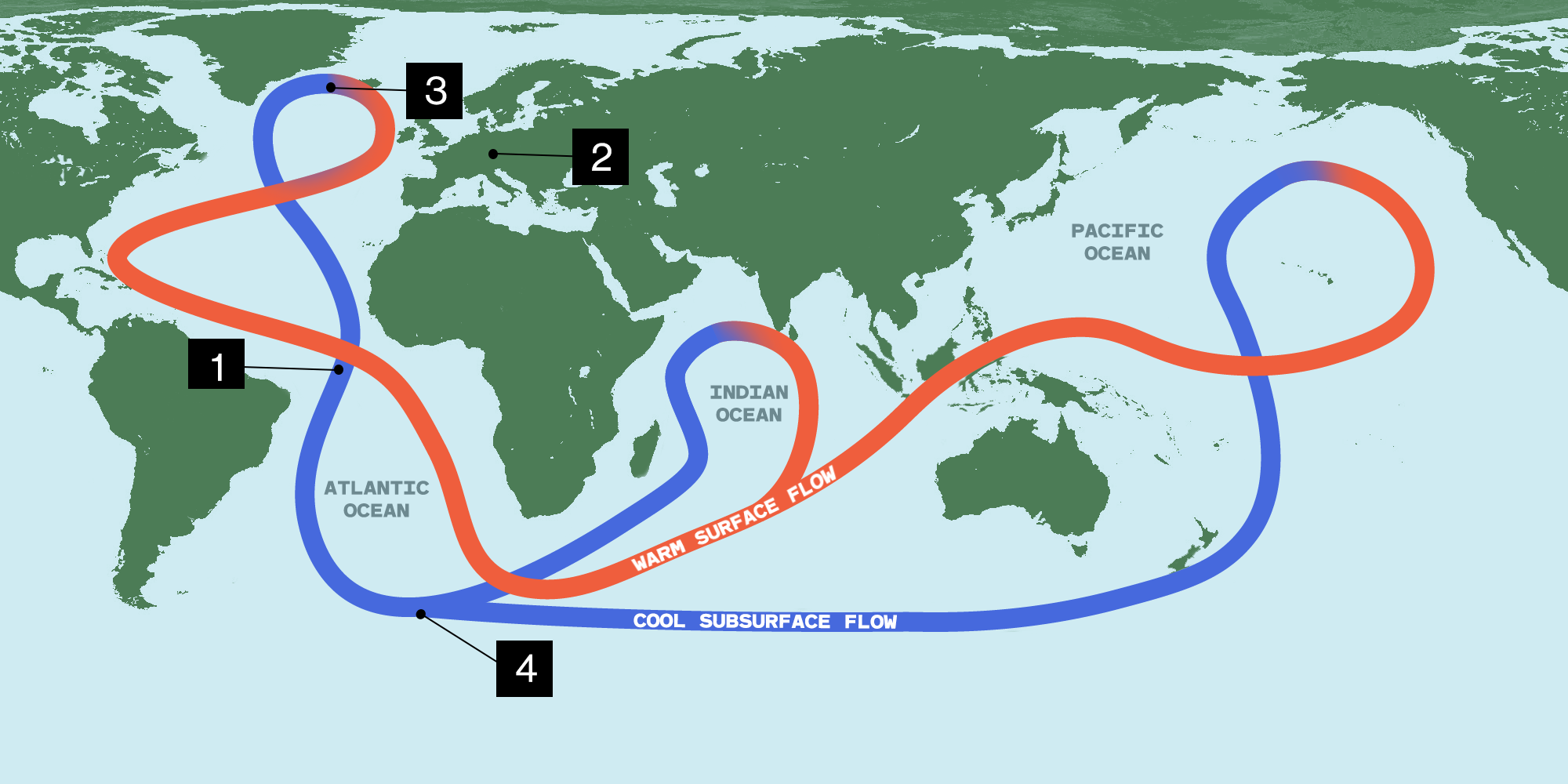
Meanwhile, William Johns and other oceanographers at the University of Miami’s Rosenstiel School of Marine and Atmospheric Science, located just across the causeway from the NOAA lab, have used sensor-strung moorings and other instruments to study the currents east of the Bahamas since the 1980s. They’ve observed both the deep, cool boundary current flowing south and a stretch of the warm northward limb that forks off and flows around the islands.
These efforts began as part of a broader push to improve scientific understanding of how the oceans work and interact with the climate, says Molly Baringer, deputy director of the NOAA lab, who helped develop the cable program.
But the ongoing cable measurements and the historical records have taken on added importance as concerns have grown about the effects global warming could have on the Atlantic circulation, and the impact that could have, in turn, on the climate. “It’s the way the ocean moves around heat,” Baringer says. “You have to understand it to understand climate change.”
Through the 1990s, there were a growing number of other attempts to measure parts of the currents, using short stretches of anchored moorings, drifting floats, shipboard observations, and other means. But oceanographers came to realize that these snapshot observations weren’t enough to fully capture the system’s behavior. They needed ways to continuously monitor the currents across the ocean in order to distinguish short-term fluctuations from long-term trends, among other things.
The UK’s National Oceanography Centre established the RAPID effort in 2004 to do just that, anchoring cables across the Atlantic. It made obvious sense to collaborate with NOAA and the University of Miami research groups as well, taking advantage of those ongoing monitoring efforts.
Moat says the researchers are trying to shed light on how variable the currents are, how much heat they deliver, how much carbon they pull down from the air, how harmonized the southward and northward limbs are, how much local winds influence the system, and—critically—whether or not the Atlantic circulation is slowing down at the rate climate models predict.
Out at sea
On a sunny day in early November, I followed a pair of NOAA researchers down a pier on the southeastern edge of the Rosenstiel School of Marine and Atmospheric Science campus.
We ascended the gangway onto the F.G. Walton Smith, a 96-foot-long catamaran with dark green hulls and a white deckhouse, owned by the University of Miami.
Roughly every quarter, at least in pre-pandemic times, researchers from both institutions have boarded the vessel for 30-hour sprints out and back to the Bahamas. They use an A-frame and winch on the stern to lower what are known as CTDs into the waters at nine stations along the way, near the line of the old telephone cable.
The CTDs include a carousel of tubes that capture water samples, as well as sensors that measure temperature, pressure, oxygen saturation, and other water properties.
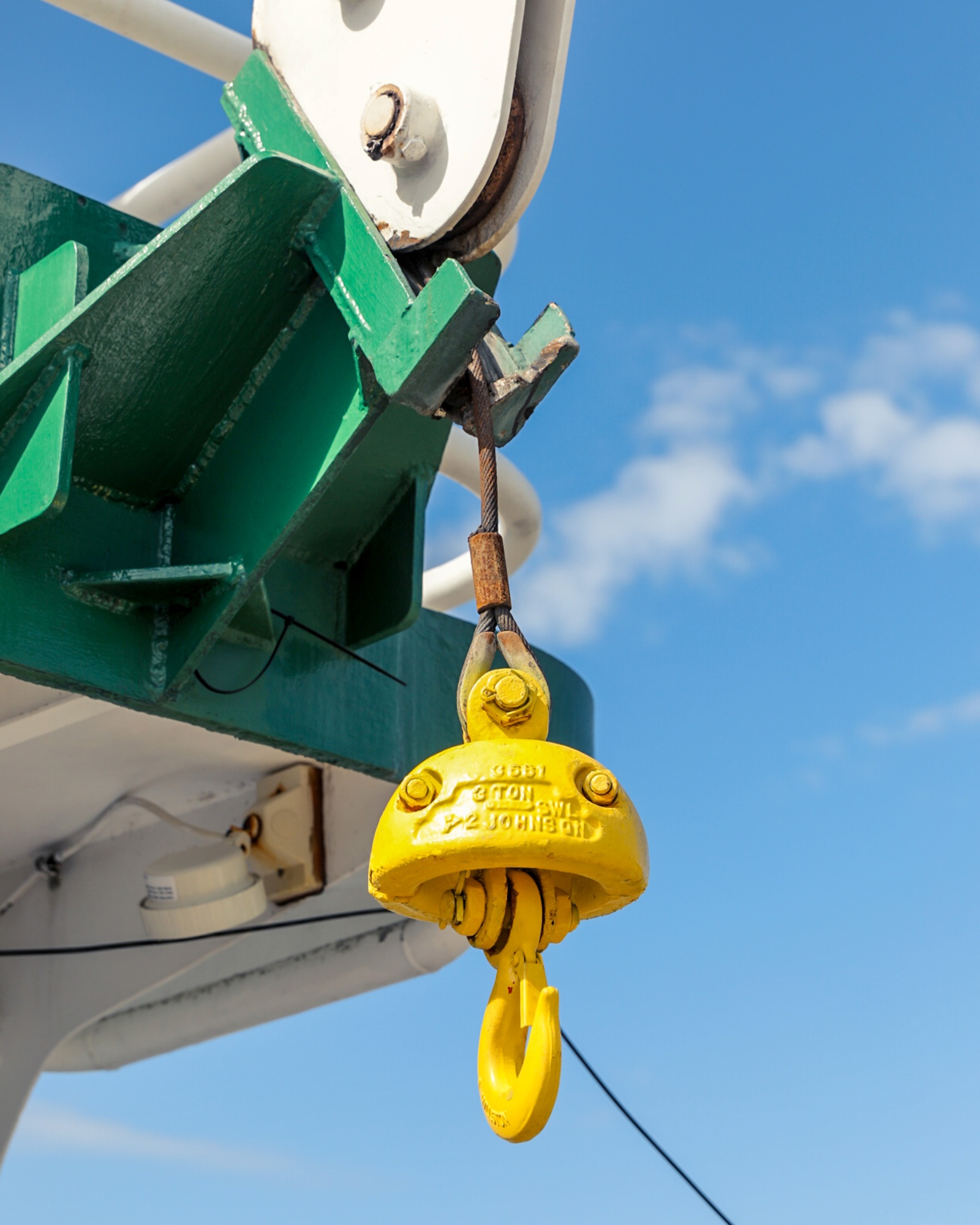
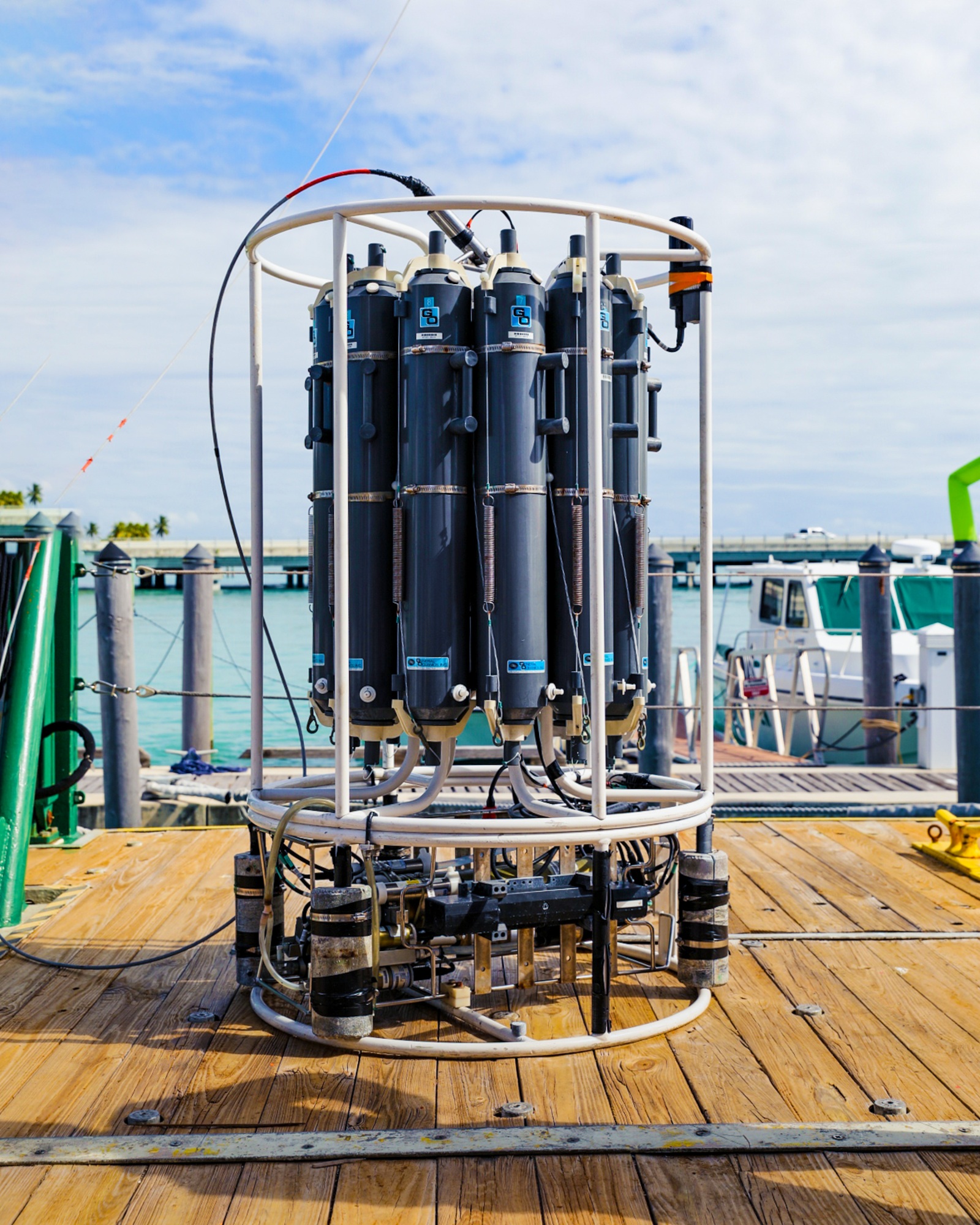
Denis Volkov, one of the principal researchers on NOAA’s monitoring project, explains that these voyages, along with more frequent excursions on smaller vessels, allow the researchers to determine how much heat and salt are moving through the straits, how fast the currents are at varying depths, where the water moving through originates, and how the currents are affecting relative sea levels along the coasts of Florida and the Bahamas.
Separately, the research teams usually go out on longer voyages every 18 months, to remove and replace sensors from three or four moorings on the eastern side of the Bahamas. Their UK counterparts do the same job on the eastern side of the ocean and along the Atlantic Ridge.
Other groups have set up arrays of moorings across different parts of the Atlantic to better understand how varying components work, how tightly the system is connected, and whether changes in one part are rippling throughout.
Susan Lozier, an oceanographer at the Georgia Institute of Technology, leads an international effort known as OSNAP, which began in 2014. It has anchored cables across the Labrador Sea and from the southeastern edge of Greenland to the coast of Scotland.
The hope of the international research effort was to go to the sources of the deep-water sinking, which is largely responsible for propelling the currents in the Atlantic, to “try to get a much better understanding of the mechanisms driving change in the AMOC,” Lozier says.
So far, what the monitoring programs have largely found is that the Atlantic circulation is more variable than previously believed, she says.
Its strength and speed fluctuate dramatically from month to month, year to year, and region to region. Most of the deep-water sinking in the North Atlantic seems to be occurring not in the Labrador Sea, as long believed, but rather in the basins to the east of Greenland. The northward- and southward-flowing limbs operate more independently than previously understood. Local wind patterns seem to exercise a more influential role than expected. And some findings are just befuddling.
It’s very likely that the Atlantic circulation has weakened. Studies by Rahmstorf of the Potsdam Institute and others have concluded it’s about 15% slower than during the mid-20th century and may be at its weakest in more than 1,000 years. Both findings are based, in part, on long-term reconstructions of its behavior using records like Atlantic Ocean temperatures and the size of grains on the ocean floor, which can reflect changes in deep-sea currents.
There’s also “strong agreement” in models that the currents will continue to weaken this century if greenhouse-gas emissions continue.
But there’s uncertainty about what state the system is in at the moment, and whether the direct observations are aligning with the models.
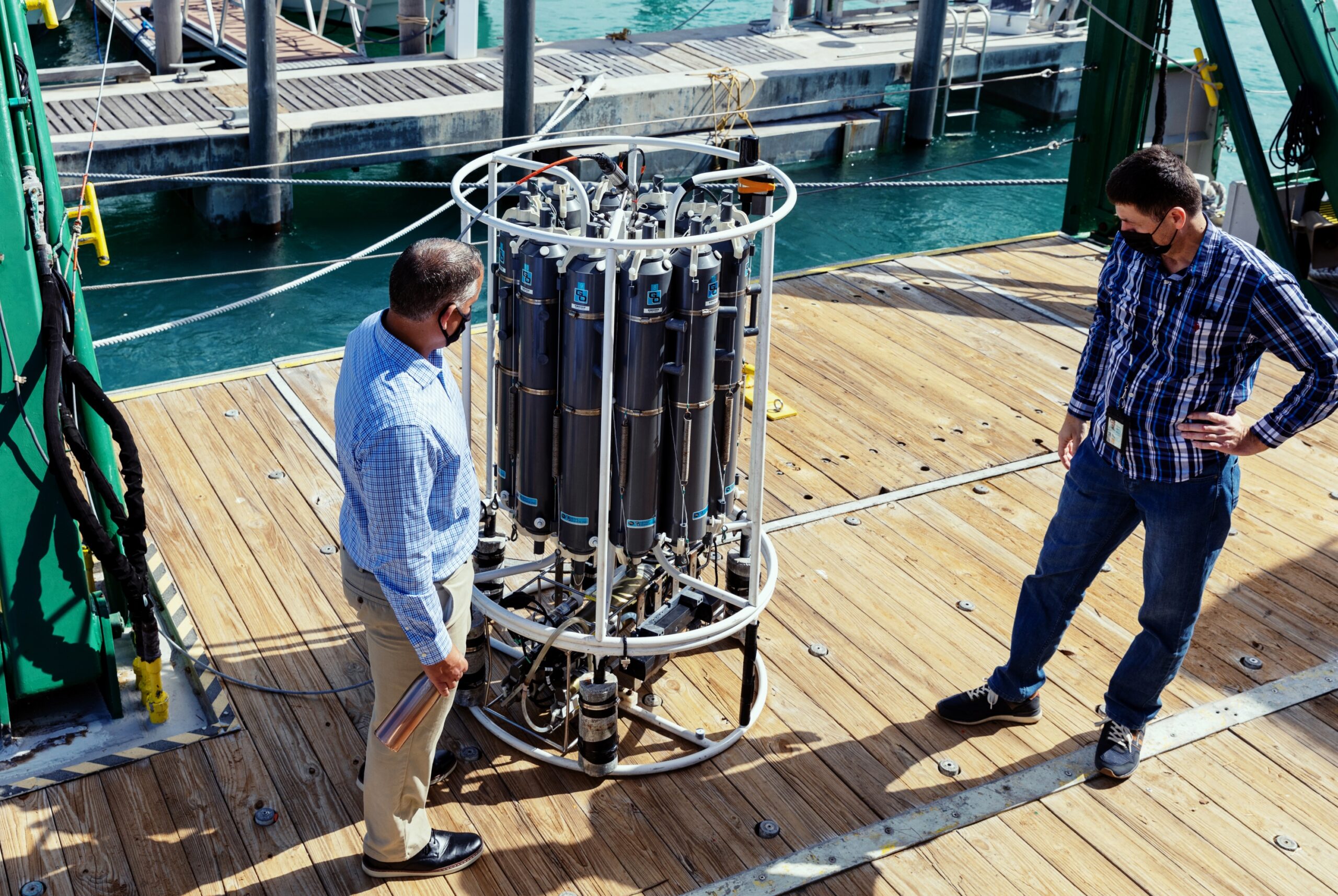
ALFONSO DURAN
Data from the RAPID moorings showed a general weakening in the Atlantic circulation from 2004 to 2012, with a sudden 30% drop from 2009 to 2010. That was likely a major contributor to an especially cold winter in northwest Europe in 2012, as well as rapid sea-level rise in that period along the northeastern US coast, reaching about 13 centimeters around New York. The slowdown was an order of magnitude larger than global climate models predicted.
The currents rebounded substantially in the years that followed. But the strength of the circulation is still below where it was when the measurements started. In fact, it has decreased even more than climate-change models predicted.
Some say the data suggests that the system has already shifted into a weaker state. But it showed such a wild swing that others believe it was more likely an indication how much the ocean currents can vary across a decade, rather than any clear result linked to global warming.
Johns says it’s simply unclear at this point. “We can’t be 100% sure whether it’s a longer-term trend—i.e., related to climate change—or an oscillation that can happen naturally,” he said during an interview in his office overlooking the Florida Straits.
An added wrinkle is that the Florida Current flowing by in the background has only declined a small amount since 1982, and not quite a statistically significant amount at that, according to NOAA’s findings. That’s weird, because that powerful, concentrated flow is “the place you’d most expect” to see a weakening trend according to climate models, Johns says. The data is “showing two slightly different stories,” he says.
He and others believe it’s likely to simply take more time—years to decades—before the currents reveal clearly how climate change is affecting them.
A collapse
The reason scientists worry that the Atlantic circulation could dramatically weaken is that it repeatedly did so in the ancient past.
Nearly 13,000 years ago, as the Earth was emerging from the last ice age, the climate across the North Atlantic region suddenly began cooling again. Temperatures plunged back toward nearly glacial-era conditions for a more than 1,000-year period known as the Younger Dryas, named for a wildflower that flourished in the frosty conditions of Europe in that era.
The leading theory on what triggered it involves the Laurentide Ice Sheet, which stretched millions of square miles across North America. As temperatures rose, it rapidly melted, pouring fresh glacial water into the ocean through the Mississippi River.
At some point, ice damming a massive lake on the southern edge of the glacier may have given way, unleashing a flood that possibly rerouted the drainage to the St. Lawrence River. It would have poured fresh water into the North Atlantic through modern-day Quebec.
The massive influx of fresh water could have reduced the salinity and density of the surface water enough to undermine the mechanisms driving the Atlantic circulation at its origin, flipping it off or sending it into a very weak mode, says Jean Lynch-Stieglitz, a paleoclimate researcher at the Georgia Institute of Technology.
By the late 1980s, some scientists started to wonder: Could the effects of global warming halt the currents much as the breakup of the Laurentide likely did, bringing about a more abrupt climate shift than researchers had been considering?
For years, the UN’s Intergovernmental Panel on Climate Change has called a shutdown of the Atlantic circulation this century “very unlikely,” defined as a 0 to 10% probability. But as several studies note, the climate models have biases that could overstate the stability of the current, in part because they don’t incorporate increasing meltwater from Greenland ice sheets.
The latest UN report, released in August, downgrades the assurance that a collapse won’t occur before 2100 to “medium confidence,” citing that “neglect” in the models as well as the recent findings by a pair of scientists at the University of Copenhagen.
The researchers, Johannes Lohmann and Peter Ditlevsen, ran numerous scenarios on a model developed at the university, turning the knobs on the levels, rates, and time frames of runoff from the Greenland ice sheets.
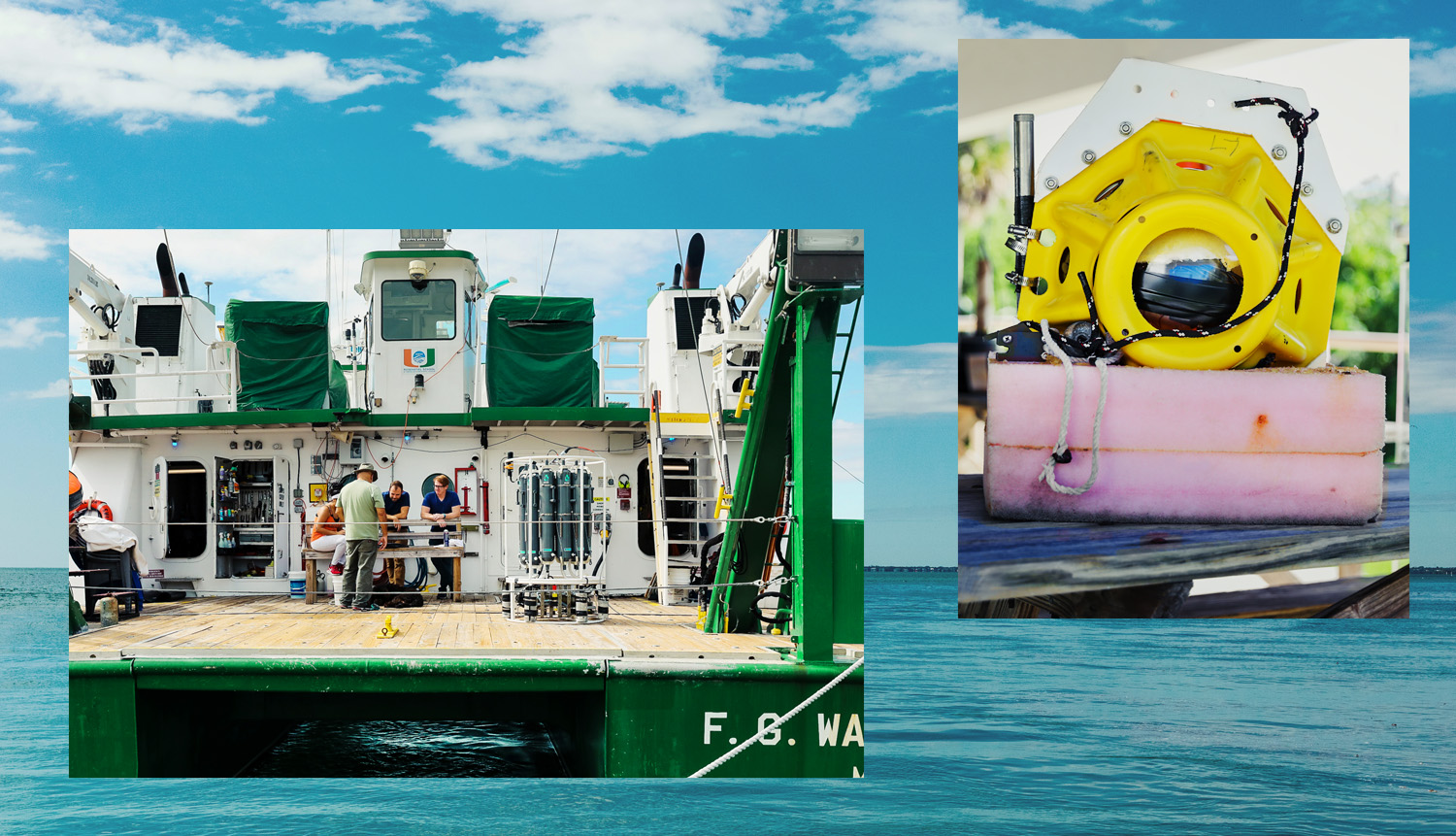
ALFONSO DURAN
The general conception of a tipping point is that there’s some fixed physical threshold beyond which the system trips into a different state. But they found that a lesser-known phenomenon known as a rate-induced tipping point, triggered by a sudden increase in the system’s rate of change, might halt the currents as well. In other words, too much change occurring too fast could cause the system to break down.
The Atlantic circulation could be susceptible to this if the water flowing from ice sheets increases rapidly enough, according to the study, which was published in the Proceedings of the National Academy of Sciences in March.
It’s just one model and one study, but it suggests that the climate system could be more fragile than previously appreciated.
These “chaotic dynamics” mean that “we maybe cannot expect, even if our models get much better, to be able to predict with 100% confidence whether such an element of the climate system will go into another state or not,” Lohmann says.
An August paper by another researcher added to these concerns, concluding that the currents might be closer than expected to the standard sort of tipping point as well.
Scientists have found telltale early warning signs of a collapse in models and geological records from the last ice age, wrote the author, Niklas Boers, a professor of Earth system modeling at the Technical University of Munich and a researcher at the Potsdam Institute for Climate Impact Research.
“The only thing we can say is that in the course of the last century the AMOC has moved toward its critical point.”
The signs include decreasing sea-surface temperatures and salinity in the North Atlantic, a salinity “pile-up” in the Southern Atlantic, and a characteristic shift in current patterns known as a “critical slowing down.” Boers found evidence of these warnings across eight different records, suggesting “an almost complete loss of stability.”
“In the course of the last century, the AMOC may have evolved from relatively stable conditions to a point close to a critical transition,” Boers wrote.
But how close is “close?”
In an email, Boers said it remains difficult to define the threshold in terms of a specific global temperature or time, given the numerous layers of uncertainty.
“The only thing we can say is that in the course of the last century the AMOC has moved toward its critical point (which on its own had not been expected by many),” he wrote in an email. “And that with every additional ton of emitted greenhouse gases, we’ll likely push it further.”
Hollywood vs. reality
So what happens if the Atlantic circulation collapses?
The Day After Tomorrow, the popular 2004 disaster film in which an abrupt halt of the currents shock-freezes the Northern Hemisphere over a few nightmarish days, is a wild Hollywood exaggeration. The changes brought about if the network of ocean currents collapsed would unfold over years or decades, not days, and there’s no reason to expect tsunamis flooding Manhattan or ice entombing the city.
But a shutdown would flip the global climate system into a fundamentally different state, inflicting somewhat unpredictable consequences across large parts of the planet.
Much of Europe could turn into a starkly different world, according to a study by researchers at the Met Office Hadley Centre in the UK, which closely analyzed the effects on that continent using a high-resolution climate model. Within 50 to 80 years after a massive infusion of fresh water that halts the Atlantic circulation, sea surface temperatures drop as much as 15 °C from the Barents to the Labrador Seas, and 2 to 10 °C across much of the rest of the North Atlantic.
Sea ice drifts farther and farther south, reaching the northern tip of the United Kingdom in late winter.
The continent experiences extensive cooling as well. Winter storms intensify, become more frequent, or both. On average, most of Europe gets drier, aside from the Mediterranean during summer. But more of the precipitation that does fall arrives in the form of snow.
Given these cooler and drier conditions, surface runoff, river flows, and plant growth all decrease.
The Garonne River in southern France carries 30% less water during peak winter periods. Growth in the needleleaf forests of Northern Europe slows by as much as 50%. Crop production “decreases dramatically” in Spain, France, Germany, Denmark, the United Kingdom, Poland, and Ukraine.
Laura Jackson, the lead author of the study, stresses that it was an “idealized” model, using a large amount of fresh water to quickly shut down the Atlantic circulation and shorten the length of the experiments. “A more realistic scenario, or a different model, might show different magnitudes of change,” she said in an email.
Still, other studies looking beyond Europe have concluded that a collapse or significant weakening of the Atlantic circulation would have wide-scale effects on much of the world.
Some models find that parts of Asia and North America could grow cooler as well. The slowing currents could disrupt the delivery of crucial nutrients, devastating certain fish populations and otherwise altering marine ecosystems.
As the Gulf Stream subsides and flattens, ocean levels could quickly rise eight to 12 inches along the southeastern US. The tropical rain belt could drift south, weakening rainfall patterns across parts of Africa and Asia and ratcheting up monsoons in the Southern Hemisphere.
A certain amount of weakening may act as a counterforce against climate change, mitigating to some degree the warming that would otherwise take place. But how these competing forces balance out overall and over time would depend on multiple, overlapping layers of uncertainty: how much the system weakens; whether it shuts down entirely; how much less carbon dioxide the oceans, forests, and farms pull down; and how much warmer the planet gets.
The ocean matters
The potential for a steep slowdown or collapse of the AMOC raises difficult questions.
How worried should we be about very low-odds but very high-consequence possibilities like a shutdown will happen this century? How can we properly evaluate the risks and take appropriate actions with so much scientific uncertainty? How much should today’s policy debates or climate actions be shaped by the danger of events that may not occur until the 2100s or 2200s, if they occur at all?
Some who study the AMOC believe that people, and the press in particular, are overly obsessed with the catastrophe scenario—“the drama” of The Day After Tomorrow, as Lozier puts it.
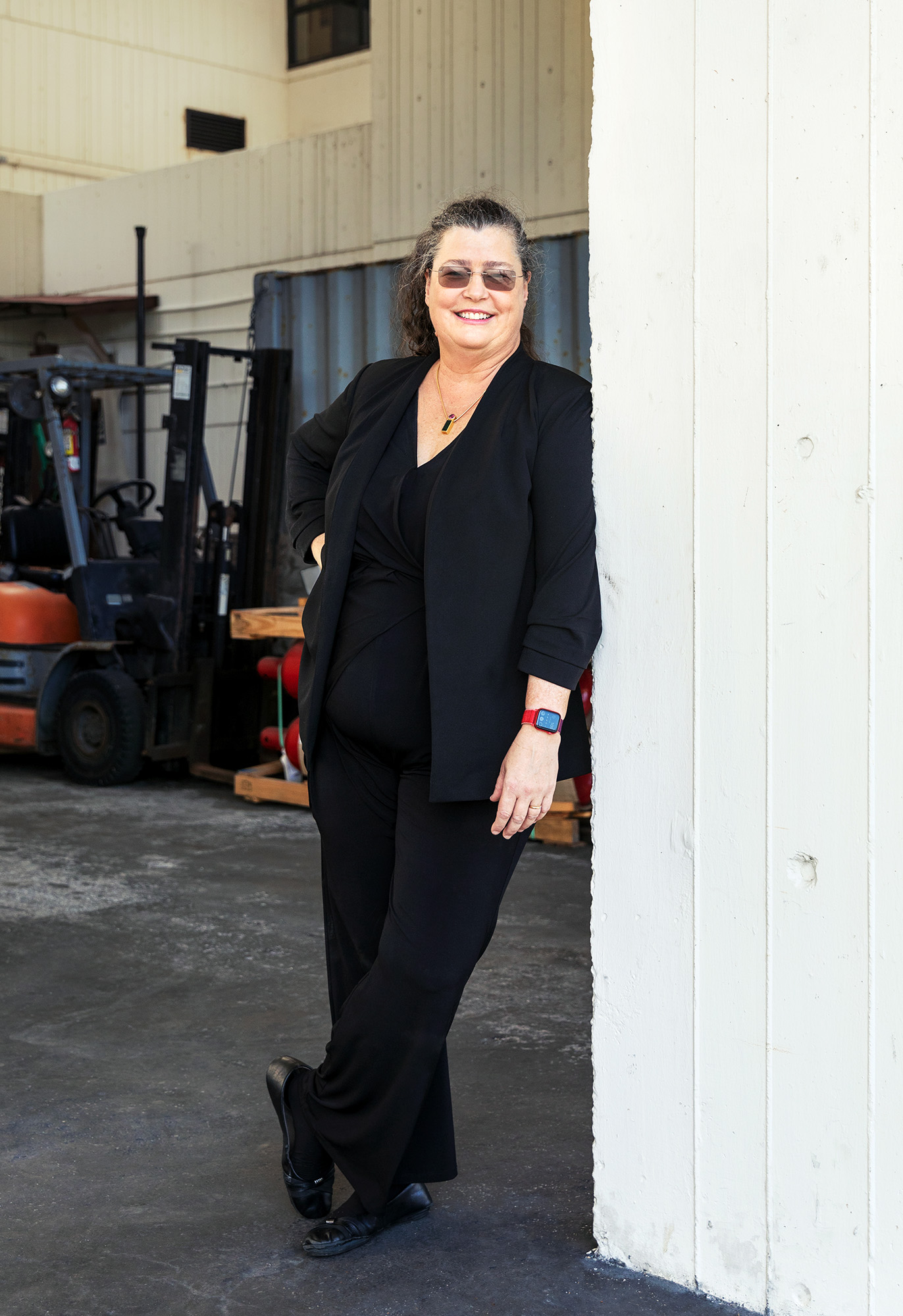
Oceanographic and Meteorological Laboratory, helped
establish NOAA’s effort
to monitor the Florida
Current using an underwater telephone cable.
ALFONSO DURAN
This, she stresses, is largely a distraction that misses the point. We don’t need some danger in the distant future to underscore the risks of climate change: there are plenty of serious consequences unfolding in the present.
“I love the AMOC and have studied it forever,” Lozier says. “But when we talk about what we should really be concerned with, it’s ocean warming, sea-level rise, ocean acidification, hurricanes. These are the things we know are happening. Those are huge impacts. So I think we just always should keep this in mind.”
When I met with Baringer, on a picnic table outside of NOAA’s lab to comply with covid protocols, I asked how concerned she is about climate models predicting a steep slowdown or possible collapse of the Atlantic circulation.
Baringer said she doesn’t “worry that much” about it. That’s in part because she thinks it’s hard to properly account for all the feedbacks in such a complex and roughly understood system—and in part because, like Lozier, she thinks there are more pressing climate concerns. She listed ocean acidification, droughts, wildfires, and sea-level rise, which she believes the field is largely underestimating.
So why, I asked, is it so important to study the Atlantic circulation?
“I don’t like that question,” she said, “because it’s sort of like asking: Why do we study oceanography in general?
“The ocean matters. The ocean carries a huge amount of heat. It sequesters carbon. It moves nutrients around. If we didn’t have the ocean circulation or upwelling, you wouldn’t have fish. The whole ocean matters, and the AMOC, that large circulation, is a big part of what the ocean is doing.”
But that is also arguably the biggest reason to worry about how human actions could alter one of the planet’s most complex—and exquisite—natural systems. There are, as Lozier and Baringer note, more imminent climate risks to worry about. But in the long term, perturbing this immensely powerful network of ocean currents could be the biggest climate risk the world is taking.
James Temple is MIT Technology Review’s senior editor on climate change.
















